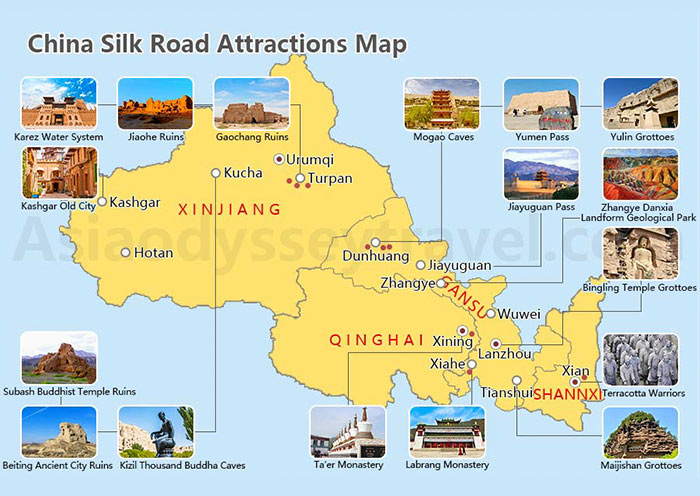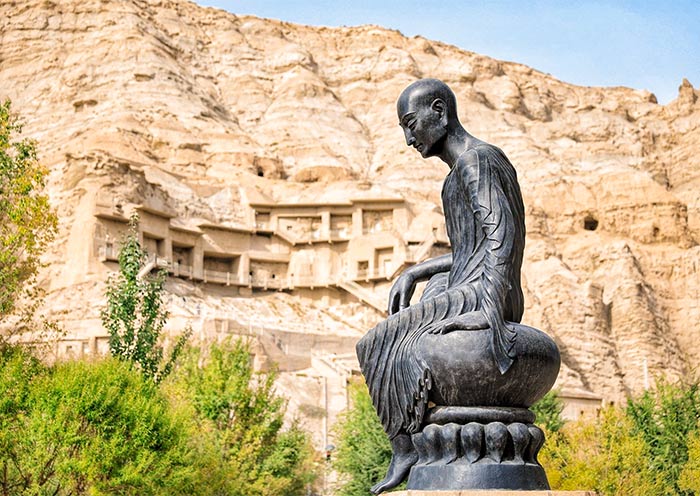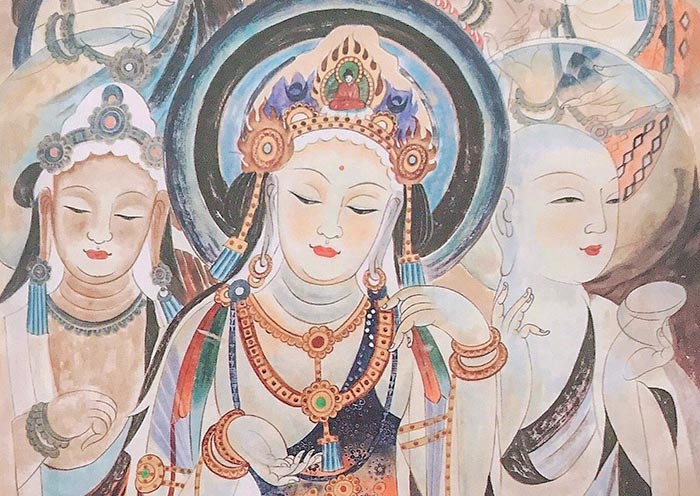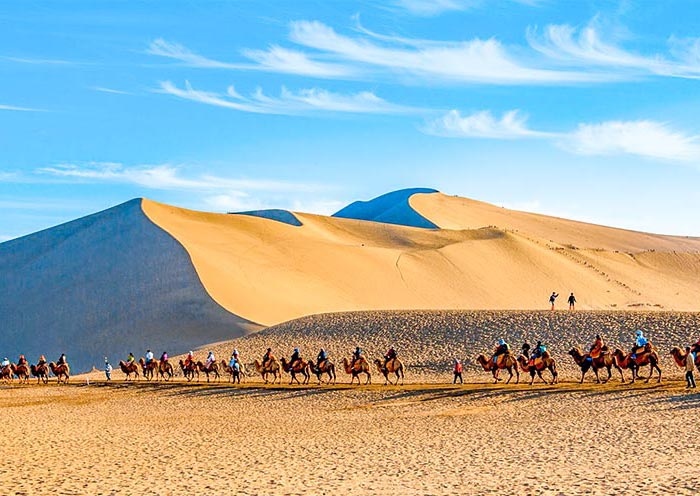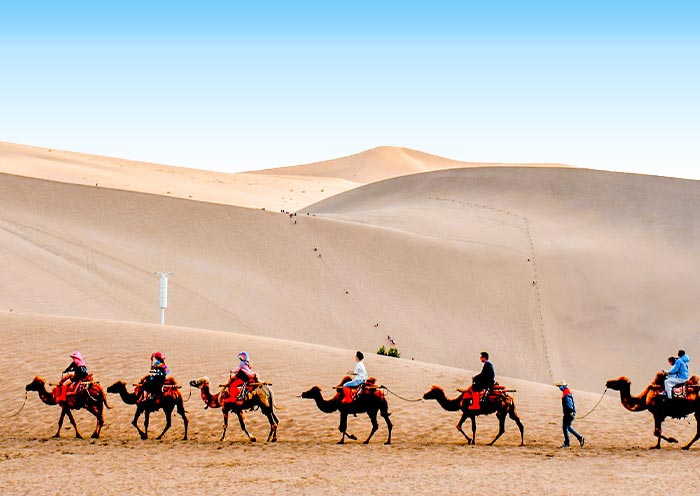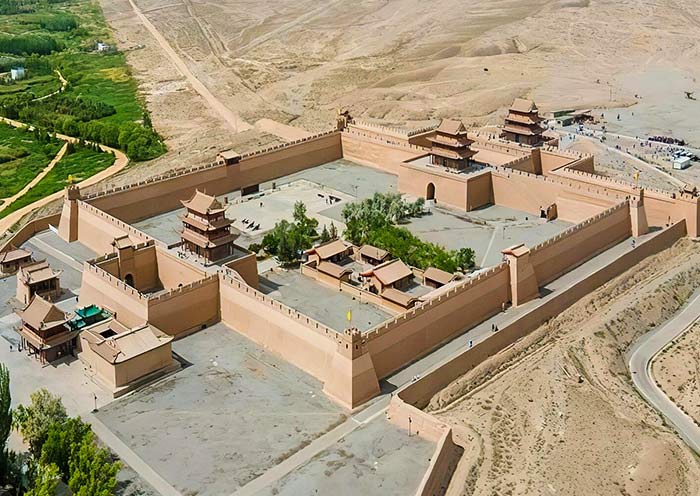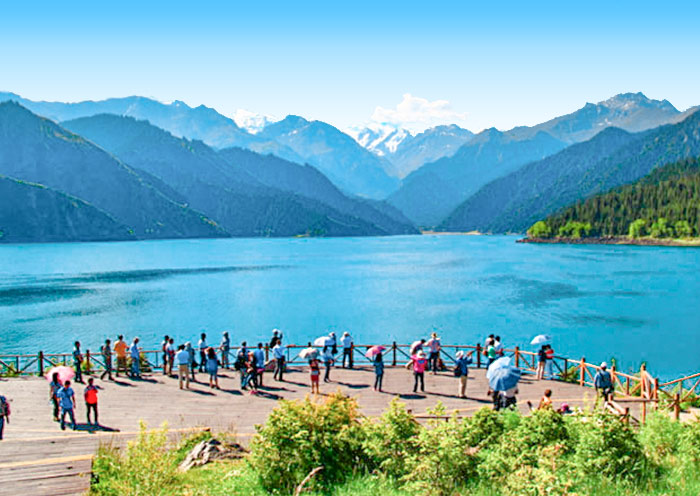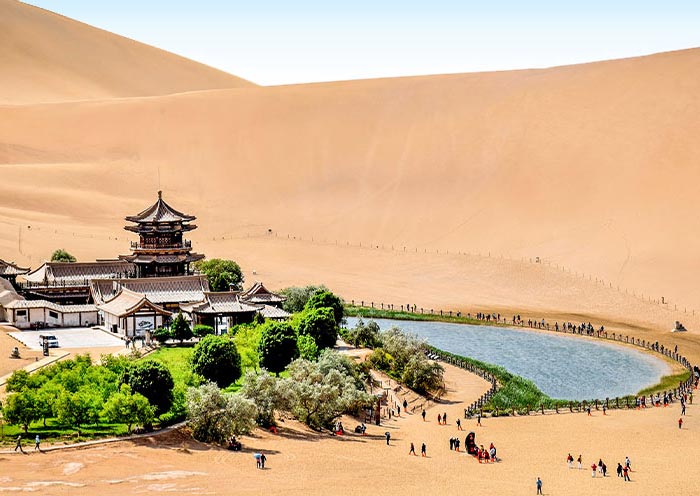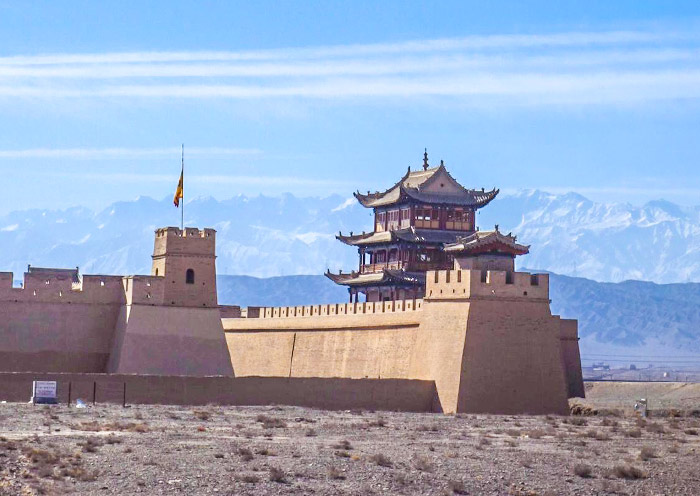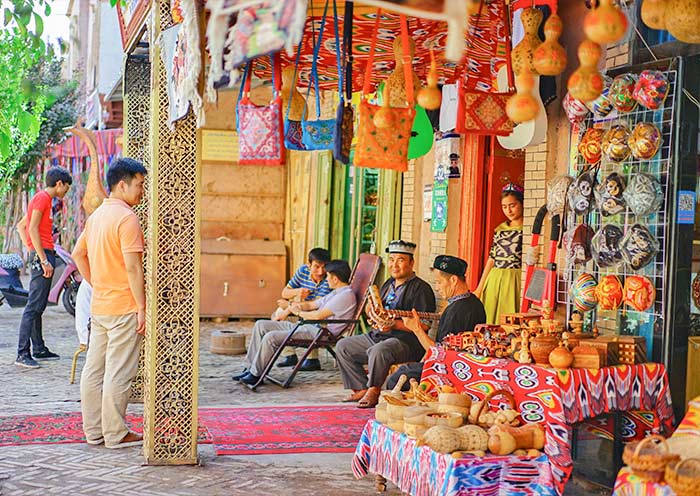When is the Best Time to Visit Silk Road China?
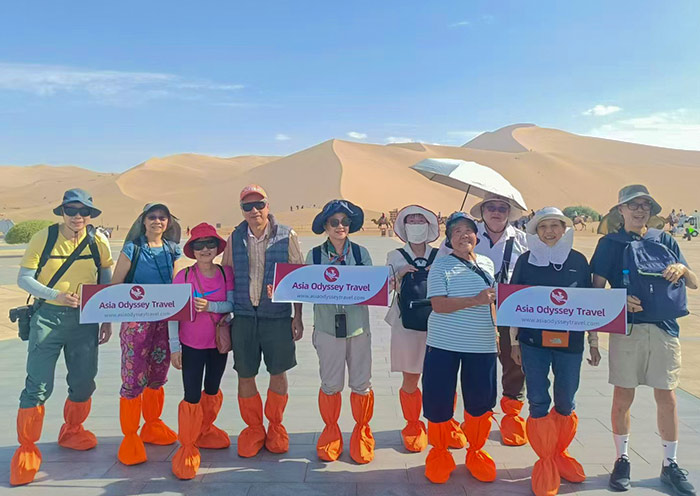
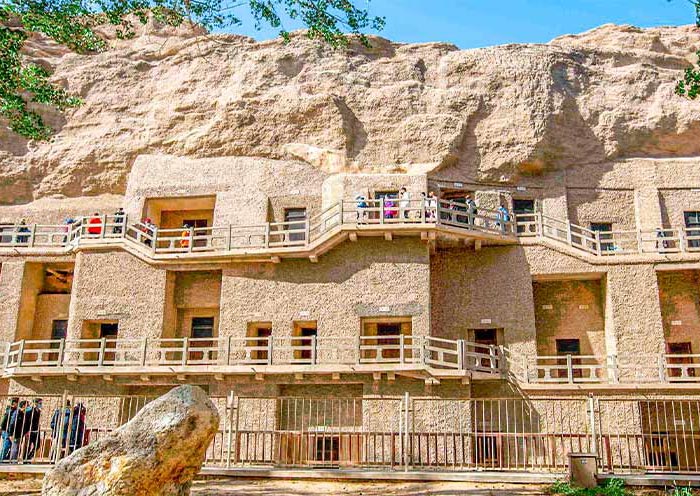
The best time to visit China Silk Road is generally from April to October. April, May, September, and October stand out as the best months for exploration.
This period allows travelers to enjoy the diverse natural landscapes, historical sites, and cultural experiences along the Silk Road without the extreme heat of summer or the harsh winter conditions. Spring and autumn offer a balance of mild weather, blooming landscapes, and clear skies, making it ideal for exploring the ancient trade route and its surrounding regions in provinces like Gansu, Xinjiang, Shanxi, and Qinghai.
Whether you're interested in exploring ancient ruins, vibrant markets, desert landscapes, or mountainous regions, visiting the Silk Road in China during the spring and autumn months provides an opportunity to appreciate the rich history and natural beauty of this iconic trade route in a comfortable and visually stunning setting.
China Silk Road in Spring (Late Mar to May): Best Time for Historical Sites
Late March to May is generally a fantastic time to visit the historical sites along the China Silk Road. During spring, With mild weather, blooming landscapes, clear skies for sightseeing, fewer crowds, and enhanced photography opportunities, this period offers a delightful blend of favorable conditions for exploring ancient ruins, historic cities, and cultural landmarks.
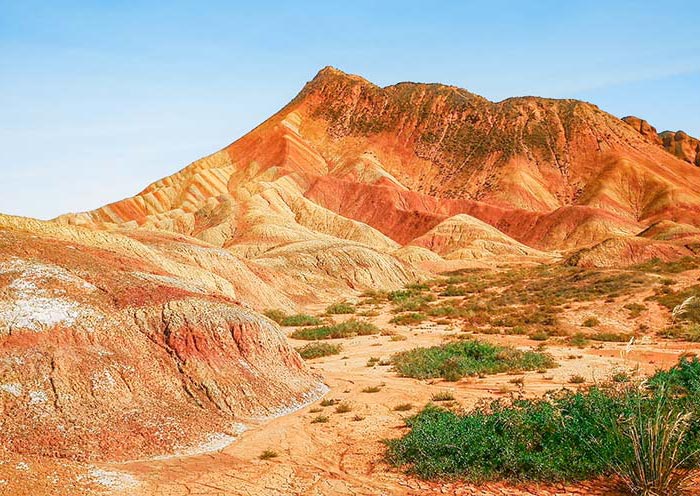
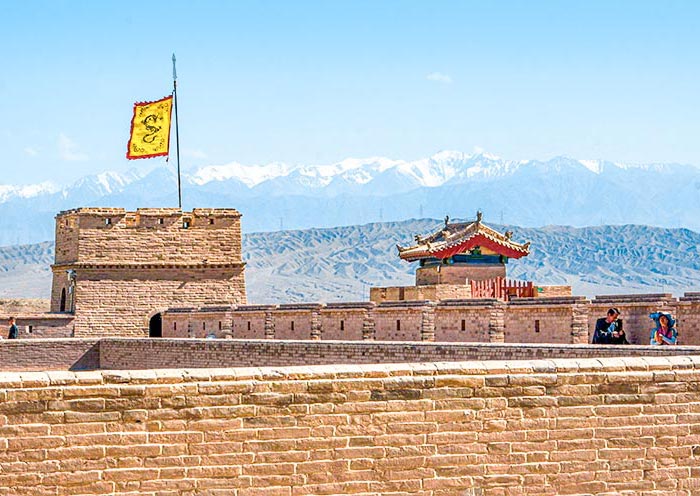
Weather in Spring along the China Silk Road:
- Temperature: During late March to May, temperatures along the Silk Road typically range from mild to warm. Daytime temperatures can vary between 15°C to 25°C, depending on the specific region you are visiting.
- Rainfall: Spring is generally a dry season along the Silk Road, with low precipitation levels. However, it's advisable to carry a light rain jacket or umbrella for unexpected showers.
- Sunshine: Spring brings increasing sunshine hours, providing ample opportunities for sightseeing and outdoor activities.
What Are the Best Destinations to Visit in Spring?
- Xi'an, Shanxi:Terracotta Army, Ancient City Wall, Big Wild Goose Pagoda
- Dunhuang, Gansu: Mogao Caves, Crescent Lake, Echoing-Sand Mountain, Yumen Pass
- Turpan, Xinjiang: Jiaohe Ruins, Gaochang Ancient City, Emin Minaret, Bezeklik Thousand Buddha Caves
- Kashgar, Xinjiang: Old City of Kashgar, Id Kah Mosque, Sunday Market, Abakh Hoja Tomb
- Jiayuguan, Gansu: Jiayuguan Fortress, Overhanging Great Wall
What to Pack for Your Spring Trip:
- Light Layers: Pack lightweight clothing suitable for mild to warm temperatures during the day and cooler evenings.
- Comfortable Footwear: Bring comfortable walking shoes for exploring historical sites and walking on uneven terrain.
- Sun Protection: Carry sunglasses, a hat, and sunscreen to shield yourself from the increasing spring sunshine.
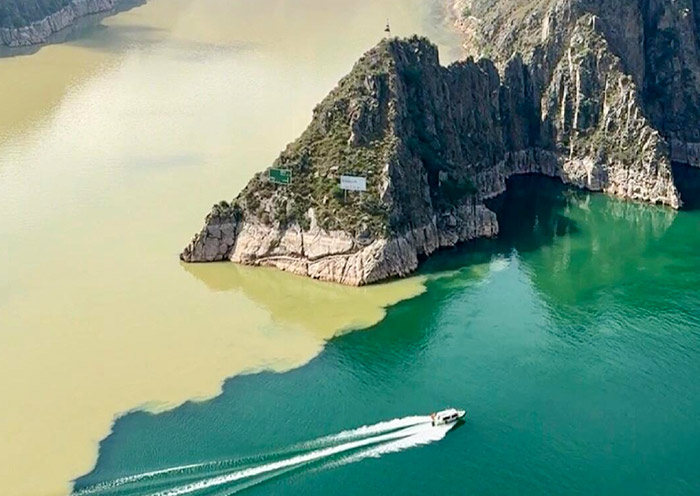
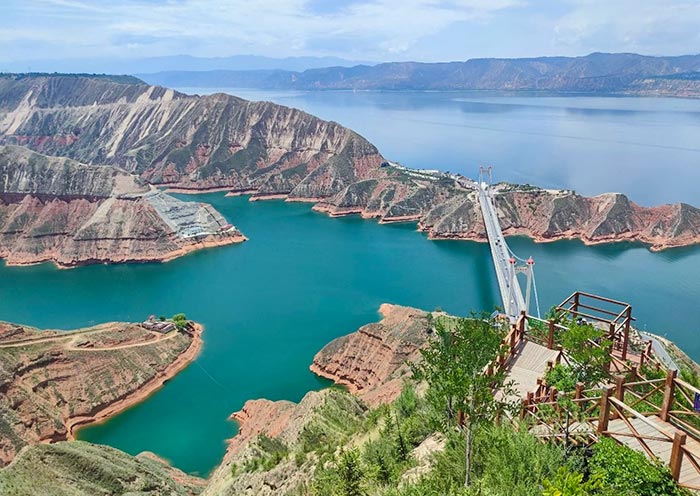
Whether you're visiting the Terracotta Army in Xi'an, the Mogao Caves in Dunhuang, or the ancient city of Kashgar in Xinjiang, spring offers an excellent balance of favorable weather, beautiful landscapes, and cultural experiences along the China Silk Road. It's a great time to immerse yourself in the rich history and heritage of this historic route.
China Silk Road in Summer (Jun to Aug): Best Time for Nature Beauty
The summer season offers an ideal time to witness the diverse natural beauty along the China Silk Road, from stunning deserts and rugged mountain ranges to lush oases and picturesque lakes. Prepare for warm temperatures, dry weather, and ample sunshine as you embark on your summer journey through this historically rich and geographically diverse region.
Weather in Summer along the China Silk Road:
- Temperature: During the summer months of June to August along the China Silk Road, temperatures can vary significantly depending on the specific region you are in. In general, temperatures can range from warm to hot, with daytime highs often exceeding 30°C (86°F) in many areas.
- Rainfall: Summer is typically a drier period along the Silk Road, with low precipitation levels. However, some regions may experience sporadic showers or thunderstorms, especially in mountainous areas or higher elevations.
- Sunshine: Summer brings abundant sunshine to the China Silk Road region, with long daylight hours perfect for outdoor activities and exploring the natural beauty of the landscapes along the ancient trade route.
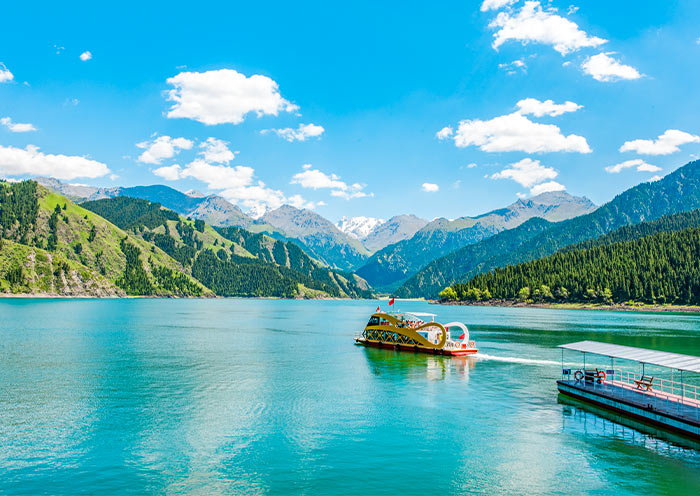
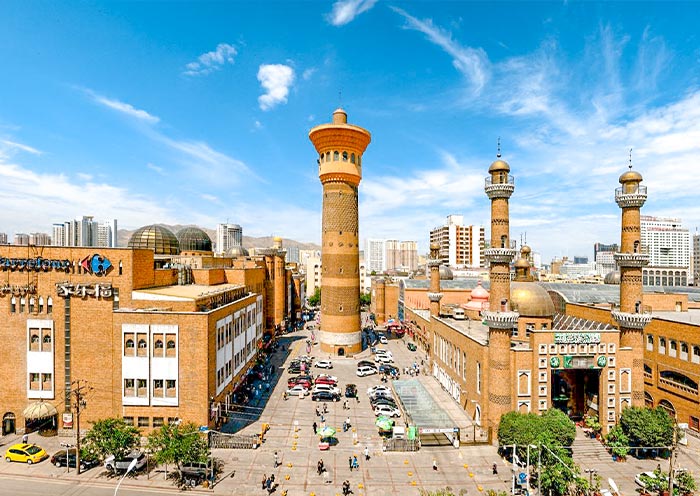
What Are the Best Destinations to Visit in Summer?
- Xinjiang: Summer is the best season for tourism in Xinjiang. Besides Turpan, summer is suitable for sightseeing in any part of Xinjiang. Snow-capped mountains, grasslands, lakes, and canyons come to life in summer. You can visit northern Xinjiang's Kanas Lake, Koktokay, and Burqin, explore Tianshan Tianchi, Sailimu Lake, head to Nalati Grassland for cool weather, or venture deep into Taxkorgan in Kashgar to experience the Pamir Plateau scenery.
- Lanzhou, Gansu: Known as the "Cool City" of China, Lanzhou offers a comfortable summer. Explore the surrounding areas of Lanzhou, including Bingling Temple and Liujiaxia Reservoir.
- Xining, Qinghai: Located on the eastern edge of the Qinghai-Tibet Plateau, Xining offers a pleasant summer and is the best season for sightseeing. Visit areas like Qinghai Lake, Chaka Salt Lake, and Menyuan Flower Sea.
What to Pack for China Silk Road in Summer
- Lightweight and breathable tops and bottoms for hot weather.
- Sun-protective clothing like hats, scarves, and sunglasses.
- Comfortable walking shoes for exploring various terrains.
- A light jacket or sweater for cooler evenings in higher altitudes.
- Sunscreen with a high SPF to protect your skin.
- Travel-sized umbrella for shade or unexpected rain showers.
- Daypack to carry essentials during day trips and hikes.
- Due to the diverse landscapes and temperatures in Xinjiang, pack versatile clothing that can be layered for cooler evenings or higher altitudes.
- Qinghai's higher altitudes may require warmer clothing layers, especially for evenings and early mornings.
- Gansu's attractions like the Bingling Temple may involve some walking or hiking, so comfortable shoes are essential.
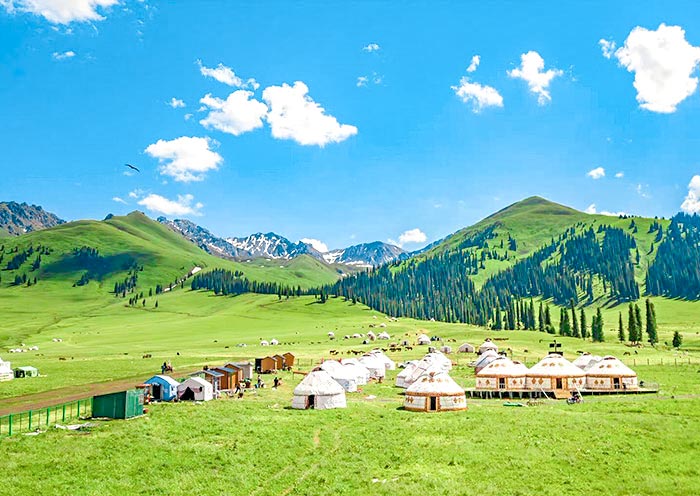
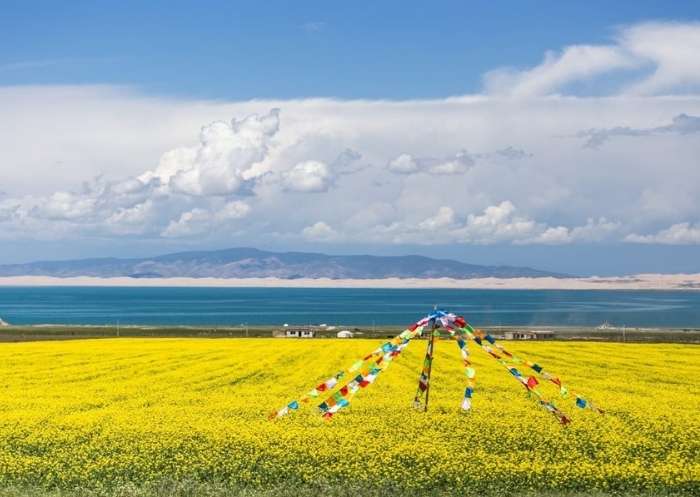
China Silk Road in Autumn (Sep to Early Nov): Best Time for Everything
Autumn is a favorable time to visit the China Silk Road, with comfortable temperatures, minimal rainfall, and abundant sunshine creating ideal conditions for travelers to experience the rich history, stunning scenery, and cultural diversity of this historic region.
Weather in Autumn along the China Silk Road:
- Temperature: During autumn along the China Silk Road, daytime temperatures are generally mild and pleasant, ranging from comfortable to slightly cool depending on the specific location. Temperatures can vary, with some areas experiencing warmer days while others may have cooler conditions. Nights and evenings tend to be cooler, so it's advisable to pack layers to stay warm during the evenings and early mornings.
- Rainfall: Autumn is generally a dry season along the Silk Road, with low precipitation levels. Rainfall is minimal during this time, making it a great season for outdoor activities and exploring the region's natural and historical attractions.
- Sunshine: Autumn offers ample sunshine along the Silk Road, with clear skies and sunny days ideal for sightseeing and enjoying the beautiful landscapes that characterize the Silk Road route. The sunshine in autumn provides a pleasant backdrop for exploring ancient ruins, scenic vistas, and cultural sites along the historic trade route.
Best Things to Do in China Silk Road During Autumn Season
- Experience the Golden Autumn in Northern Xinjiang:
- Kanas Lake: Enjoy the golden hues of autumn at Kanas Lake, known for its stunning scenery and vibrant foliage.
- Hemu Village: Explore the picturesque Hemu Village, surrounded by colorful forests and snow-capped mountains.
- Keketuohai: Visit Keketuohai for breathtaking views of autumn landscapes, including forests, lakes, and mountains.
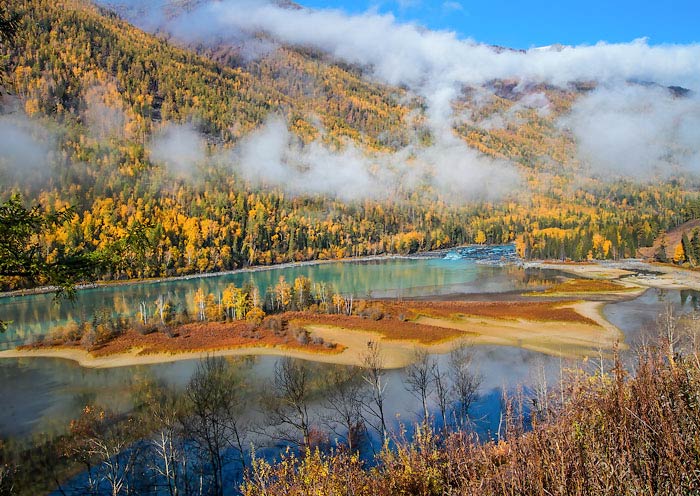
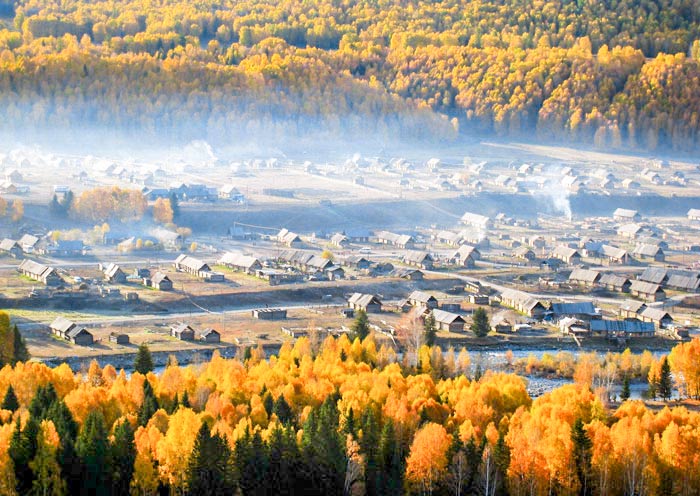
- Explore the Oldest Murals and Sculptures in Gansu's Caves:
- Mogao Caves: Discover ancient murals and sculptures at the Mogao Caves, a UNESCO World Heritage Site showcasing Buddhist art.
- Yulin Grottoes: Explore the Yulin Grottoes to admire intricate carvings and sculptures dating back centuries.
- Maijishan Grottoes: Visit the Maijishan Grottoes to witness Buddhist art carved into the mountainside.
- Bingling Temple Grottoes: Marvel at the cliffside caves and sculptures at the Bingling Temple Grottoes along the Yellow River.
- Explore Lost Ancient Cities on the Edge of the Deserts in Southern Xinjiang:
- Jiaohe Ruins in Turpan: Wander through the ruins of Jiaohe Ancient City, an abandoned desert city with a rich history.
- Gaochang Ancient City: Visit the ancient ruins of Gaochang, once an important stop on the Silk Road.
- Lost City of Loulan in the Desert: Explore the archaeological site of Loulan, an ancient city lost in the desert sands.
- Kuqa Ancient City: Discover the historical relics and ruins of Kuqa Ancient City in Xinjiang.
- Kashgar's Old City and Tashkorgan Stone City: Immerse yourself in the ancient charm of Kashgar's Old City and the stone ruins of Tashkorgan.
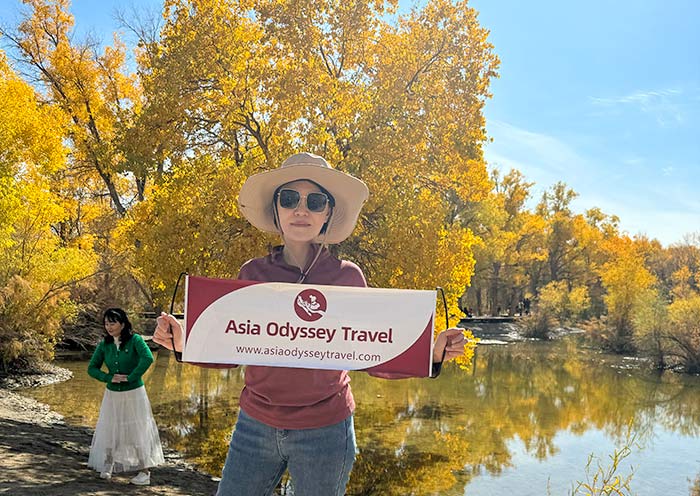
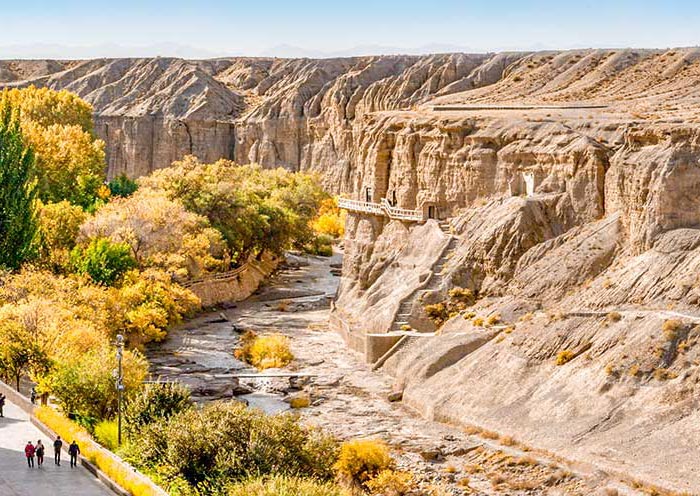
Autumn along the China Silk Road offers a perfect opportunity to witness the beauty of nature, explore ancient history, and immerse yourself in unique cultural experiences. From vibrant autumn landscapes in Northern Xinjiang to ancient caves and lost cities in Gansu and Southern Xinjiang, the Silk Road beckons travelers to indulge in a journey filled with history, art, and natural wonders during this enchanting season.
What to Pack for Your Autumn Journey along the China Silk Road:
- Layered Clothing: Pack layers including long-sleeved shirts, sweaters, and a jacket to adjust to changing temperatures from cool mornings to mild days and chilly evenings.
- Comfortable Footwear: Bring sturdy shoes suitable for walking on uneven terrain while exploring historical sites and natural wonders along the Silk Road.
- Scarf or Shawl: Carry a scarf or shawl to keep warm during cooler evenings and to protect against wind in open areas.
- Hat and Gloves: Pack a hat to shield from the sun during the day and to keep warm at night. Gloves can be handy for cooler mornings and evenings.
- Daypack: Carry a lightweight daypack to hold essentials like water, snacks, a camera, and a travel guide during your explorations.
- Sun Protection: Pack sunglasses, a wide-brimmed hat, and high SPF sunscreen to shield yourself from the sun's rays, which can still be strong in autumn.
China Silk Road in Winter (Late Nov to Early Mar): Cold
Winter along the China Silk Road brings a unique charm and a different perspective to this historic route. Here are some key aspects to consider when traveling along the Silk Road during the winter months:
Weather Conditions:
- Temperature: Winter temperatures along the Silk Road can vary significantly, with some areas experiencing freezing cold conditions while others may be milder. Be prepared for cold weather and dress warmly in layers.
- Snowfall: Some regions along the Silk Road may receive snowfall during the winter months, transforming the landscapes into a winter wonderland. Snow can add a magical touch to historical sites and natural scenery.
- Sunlight: Days are shorter during winter, with less daylight for exploration. Plan your activities accordingly and make the most of the daylight hours.
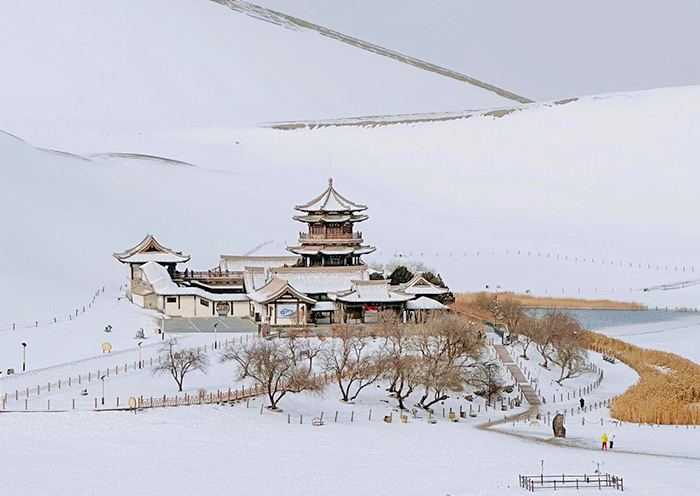
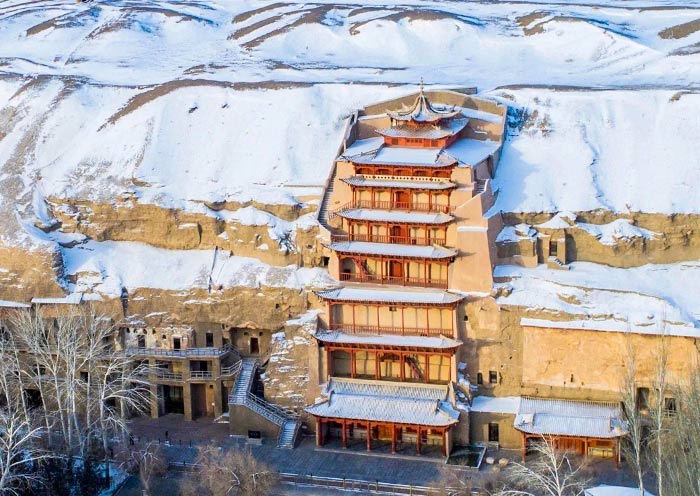
Travel Considerations:
- Tourist Crowds: Winter is typically the off-peak season along the Silk Road, meaning fewer tourists and potentially more solitude at popular attractions. Enjoy quieter visits to historical sites and cultural landmarks.
- Road Conditions: Check road conditions and transportation options, as winter weather may affect travel routes in some areas. Be prepared for possible delays or changes in itinerary due to snow or ice.
- Local Festivals: Experience winter festivals and cultural events in towns along the Silk Road, offering insight into local traditions and celebrations during the colder months.
Activities and Attractions:
- Winter Sports: Engage in winter sports activities such as skiing, snowboarding, or ice skating in Northern Xinjiang with suitable facilities along the Silk Road.
- Cultural Exploration: Visit museums, art galleries, and indoor attractions in Urumqi, Turpan, Xining, Dunhuang and Lanzhou to learn more about the history and culture of the Silk Road region during the winter season.
- Local Cuisine: Indulge in warm and hearty local dishes to savor the flavors of winter cuisine along the Silk Road, including hot soups, stews, and traditional winter delicacies. Xinjiang and Lanzhou offers a lot dishes for you.
Exploring the China Silk Road in winter offers a unique opportunity to witness the beauty of the region in a different light, with snow-covered landscapes, cultural experiences, and seasonal activities adding to the allure of this historic route. Be prepared for cold weather, embrace the winter ambiance, and enjoy a memorable journey along the ancient path of the Silk Road during the winter months.
Worst Time to Visit China Silk Road: Avoid Big Crowds during Public Holidays of China
The worst time to visit the Silk Road in China is during Chinese public holidays. These periods are characterized by massive crowds, higher prices, and limited availability of accommodations and transportation.
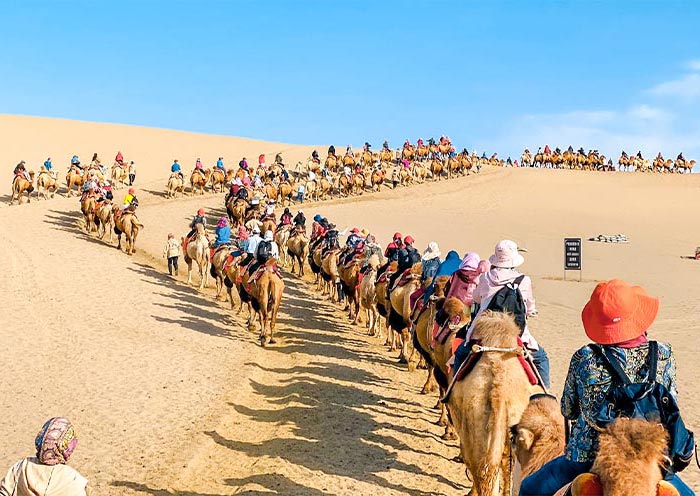
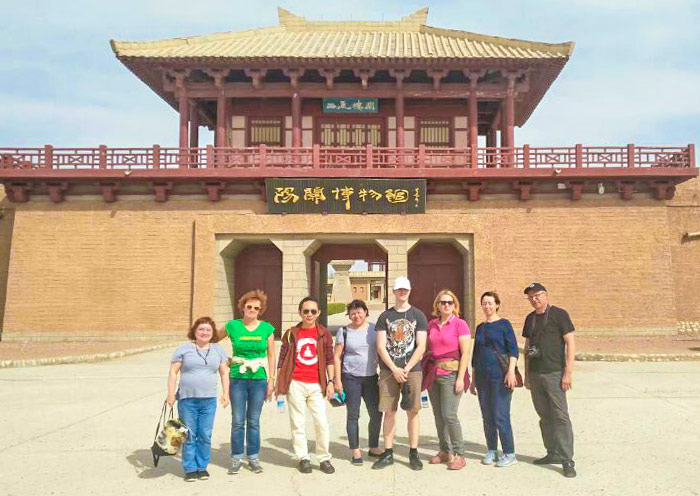
Here are the major Chinese public holidays to avoid:
- Chinese New Year: This is the most significant holiday in China, and it typically falls in late January or early February. During this time, many Chinese people travel to popular tourist destinations, including the Silk Road.
- May Day Holiday: This holiday usually takes place around May 1st and often includes a long weekend.
- National Day Holiday: This holiday occurs around October 1st and is another peak travel period.
By avoiding these public holidays, you can enjoy a more peaceful and less crowded experience on the Silk Road.
Monthly Temperature of Popular Destinations along China Silk Road
Monthly Temperature of Xi'an
| Jan | -4°C to 5°C | May | 14°C to 26°C | Sep | 18°C to 25°C |
|---|---|---|---|---|---|
| Feb | -1°C to 8 °C | Jun | 19°C to 32°C | Oct | 13°C to 20°C |
| Mar | 4°C to 15°C | Jul | 22°C to 33°C | Nov | 6°C to 13°C |
| Apr | 10°C to 22°C | Aug | 25°C to 32°C | Dec | -1°C to 6°C |
Xi'an's climate is characterized by hot summers, cold winters, and relatively dry conditions throughout the year. Spring and autumn are generally the best times to visit Xi'an due to the comfortable temperatures and clear skies.
Monthly Temperature of Dunhuang
| Jan | -12°C to -3°C | May | 10°C to 25°C | Sep | 9°C to 27°C |
|---|---|---|---|---|---|
| Feb | -10°C to 5 °C | Jun | 14°C to 31°C | Oct | 5°C to 19°C |
| Mar | -4°C to 12°C | Jul | 17°C to 33°C | Nov | -6°C to 4°C |
| Apr | 4°C to 20°C | Aug | 15°C to 32°C | Dec | -10°C to 0°C |
Dunhuang experiences a desert climate with low humidity and scarce rainfall throughout the year. The region is known for its clear skies and abundant sunlight. Extreme temperature differences between day and night are common, so visitors should be prepared for these fluctuations.
Monthly Temperature of Zhangye
| Jan | -14°C to 1°C | May | 10°C to 23°C | Sep | 10°C to 24°C |
|---|---|---|---|---|---|
| Feb | -11°C to 7 °C | Jun | 15°C to 27°C | Oct | 0°C to 15°C |
| Mar | -4°C to 12°C | Jul | 17°C to 30°C | Nov | -7°C to 7°C |
| Apr | 4°C to 20°C | Aug | 15°C to 28°C | Dec | -15°C to -2°C |
Zhangye's climate is characterized by low humidity, limited rainfall, and significant temperature variations between day and night throughout the year. The region is known for its arid landscapes and unique geological formations like the colorful Danxia landforms.
Monthly Temperature of Jiayuguan
| Jan | -13°C to -1°C | May | 10°C to 22°C | Sep | 11°C to 24°C |
|---|---|---|---|---|---|
| Feb | -6°C to 4°C | Jun | 17°C to 29°C | Oct | 5°C to 19°C |
| Mar | 0°C to 13°C | Jul | 19°C to 31°C | Nov | -4°C to 7°C |
| Apr | 4°C to 15°C | Aug | 17°C to 30°C | Dec | -10°C to 0°C |
Jiayuguan experiences a desert climate with hot, dry summers and cold, dry winters, characterized by minimal precipitation and significant temperature fluctuations between day and night throughout the year. Sandstorms can occur, particularly in the spring, due to its desert location.
Monthly Temperature of Turpan
| Jan | -10°C to -2°C | May | 22°C to 34°C | Sep | 22°C to 33°C |
|---|---|---|---|---|---|
| Feb | 0°C to 9 °C | Jun | 26°C to 36°C | Oct | 10°C to 20°C |
| Mar | 8°C to 12°C | Jul | 30°C to 41°C | Nov | -2°C to 6°C |
| Apr | 15°C to 25°C | Aug | 27°C to 37°C | Dec | -7°C to 0°C |
Turpan is known as the "Fire City" due to its extremely hot and dry climate. It experiences a continental arid desert climate with high temperatures, especially during the summer months. The average rainfall is very low, making it one of the driest places in China.
Monthly Temperature of Urumqi
| Jan | -12°C to -7°C | May | 17°C to 29°C | Sep | 15°C to 27°C |
|---|---|---|---|---|---|
| Feb | -12°C to 5 °C | Jun | 20°C to 32°C | Oct | 4°C to 14°C |
| Mar | 0°C to 8°C | Jul | 21°C to 33°C | Nov | -4°C to 4°C |
| Apr | 9°C to 21°C | Aug | 18°C to 29°C | Dec | -15°C to -10°C |
Urumqi, the capital of Xinjiang in China, has a continental arid climate with hot summers and cold winters. Temperatures can vary greatly between day and night, and the city experiences low precipitation throughout the year.
Monthly Temperature of Kashgar
| Jan | -8°C to 1°C | May | 15°C to 26°C | Sep | 15°C to 27°C |
|---|---|---|---|---|---|
| Feb | -4°C to 6 °C | Jun | 18°C to 31°C | Oct | 7°C to 19°C |
| Mar | 6°C to 17°C | Jul | 21°C to 33°C | Nov | 1°C to 12°C |
| Apr | 13°C to 24°C | Aug | 17°C to 27°C | Dec | 0°C to -9°C |
Kashgar has a continental arid climate with cold, dry winters and hot, dry summers. However, due to its location in the Tarim Basin, it experiences extreme temperature fluctuations.
Monthly Temperature of Xining
| Jan | -11°C to 2°C | May | 6°C to 20°C | Sep | 7°C to 20°C |
|---|---|---|---|---|---|
| Feb | -10°C to 3 °C | Jun | 11°C to 23°C | Oct | 3°C to 12°C |
| Mar | -1°C to 13°C | Jul | 13°C to 27°C | Nov | -4°C to 7°C |
| Apr | 2°C to 16°C | Aug | 15°C to 25°C | Dec | -12°C to 0°C |
Xining, located in Qinghai province, has a cool-summer humid continental climate with chilly winters. Summers are mild, and the city experiences a significant temperature range between day and night.
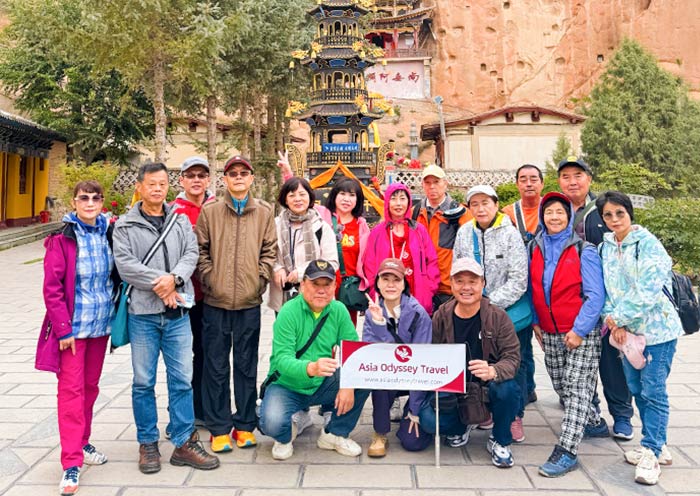
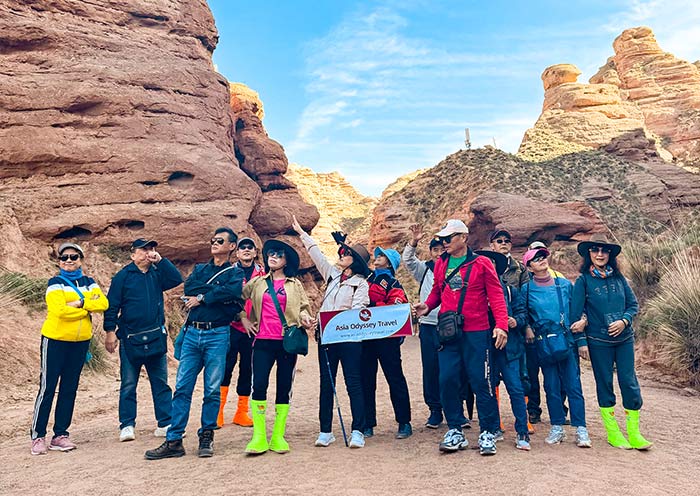
How to Plan a China Silk Road Tour?
- Day 1: Arrival in Xi'an, free activities.
- Day 2: Visit the Terracotta Warriors, the Bell Tower, and the Muslim Quarter in Xi'an.
- Day 3: Explore the Ancient City Wall, visit a local family, see the Big Wild Goose Pagoda, and experience the Tang Dynasty Music and Dance Show in Xi'an.
- Day 4: Fly from Xi'an to Dunhuang; visit the Mingsha Sand Dunes and Crescent Moon Spring.
- Day 5: Dunhuang tour, including the Mogao Caves (a UNESCO World Heritage site); take the high-speed train to Turpan.
- Day 6: Explore Turpan: visit the Jiaohe Ancient City Ruins (a UNESCO site), the Karez Water System (a UNESCO heritage project), and the Emin Minaret; then drive to Urumqi.
- Day 7: Urumqi - Heavenly Lake - Urumqi (including breakfast and lunch).
- Day 8: Fly from Urumqi to Kashgar; visit the Old City in Kashgar (Id Kah Mosque, Ancient Teahouse), and the Livestock Market (only on Sundays).
- Day 9: Kashgar - Karakul Lake - Kashgar | Pamir Plateau, White Sand Lake, Karakul Lake.
- Day 10: Depart from Kashgar | Check out from the hotel and transfer to the airport.
Travel with Asia Odyssey Travel (AOT) to Explore Silk Road
Travel the historic Silk Road with Asia Odyssey Travel (AOT) and delve into the rich tapestry of cultures and landscapes that shaped the path of trade and civilization. With our deep expertise and over a decade of experience crafting journeys throughout this legendary route, AOT offers tailored tour packages that cater to a wide range of interests and preferences.
Tour Packages: Silk Road Tours, Silk Road Group Tours, China Silk Road Tours, China Northwest Tours, Xinjiang Silk Road Tours
Silk Road Destinations: Xi’an, Lanzhou, Zhangye, Jiayuguan, Dunhuang, Turpan, Urumqi, Kashgar
Popular Attractions: Mogao Caves, Hexi Corridor, Kashgar Old City, Karez System, Tianshan Tianchi, Jiaohe Ruins, Kanas Lake, Qinghai Lake, Chaka Salt Lake, Badain Jaran Desert
Silk Road Travel: Silk Road Travel Guide, Silk Road Cities, Silk Road Trip Planning Guide, Silk Road Itinerary, Silk Road Attractions, Silk Road Map, Silk Road Facts
